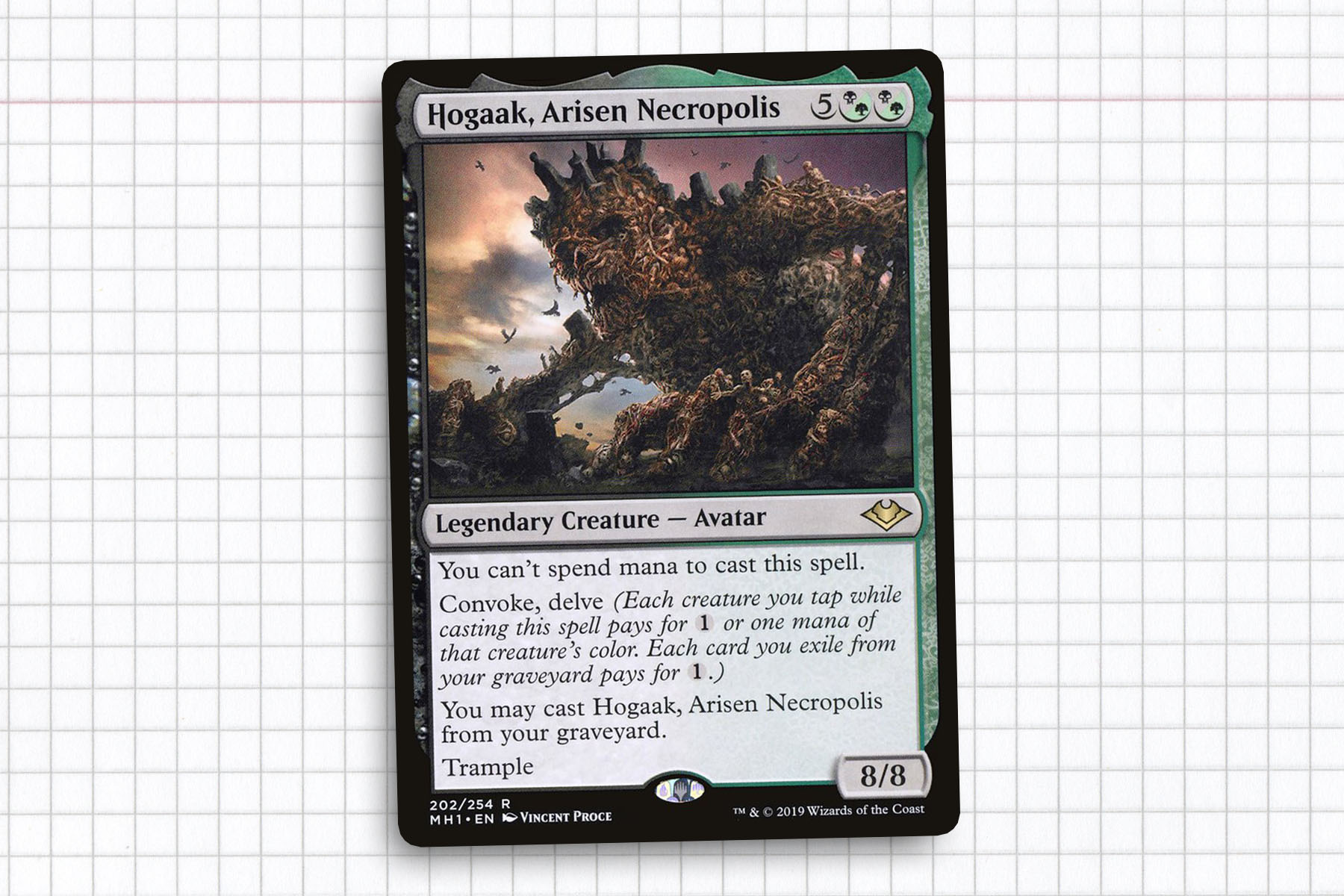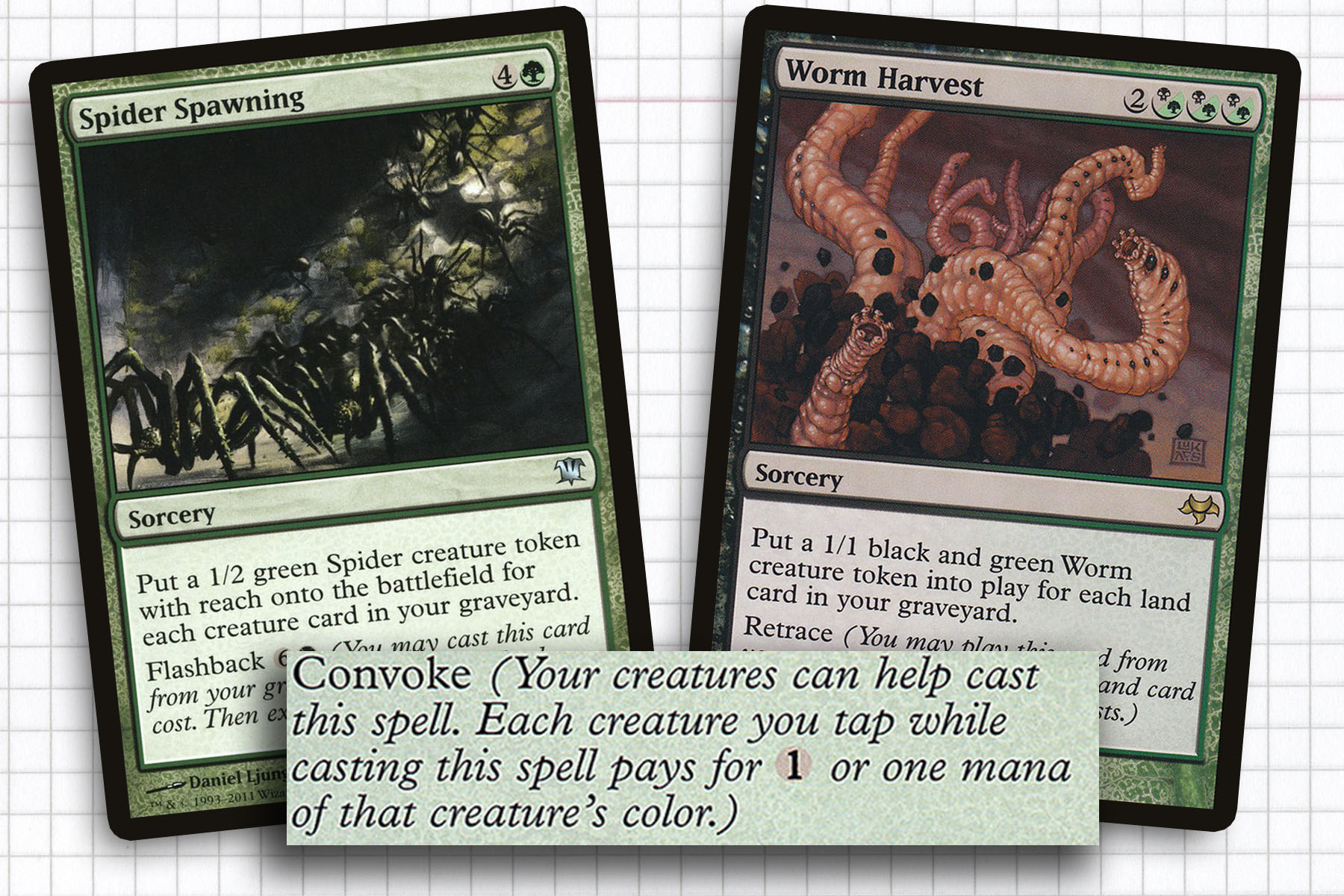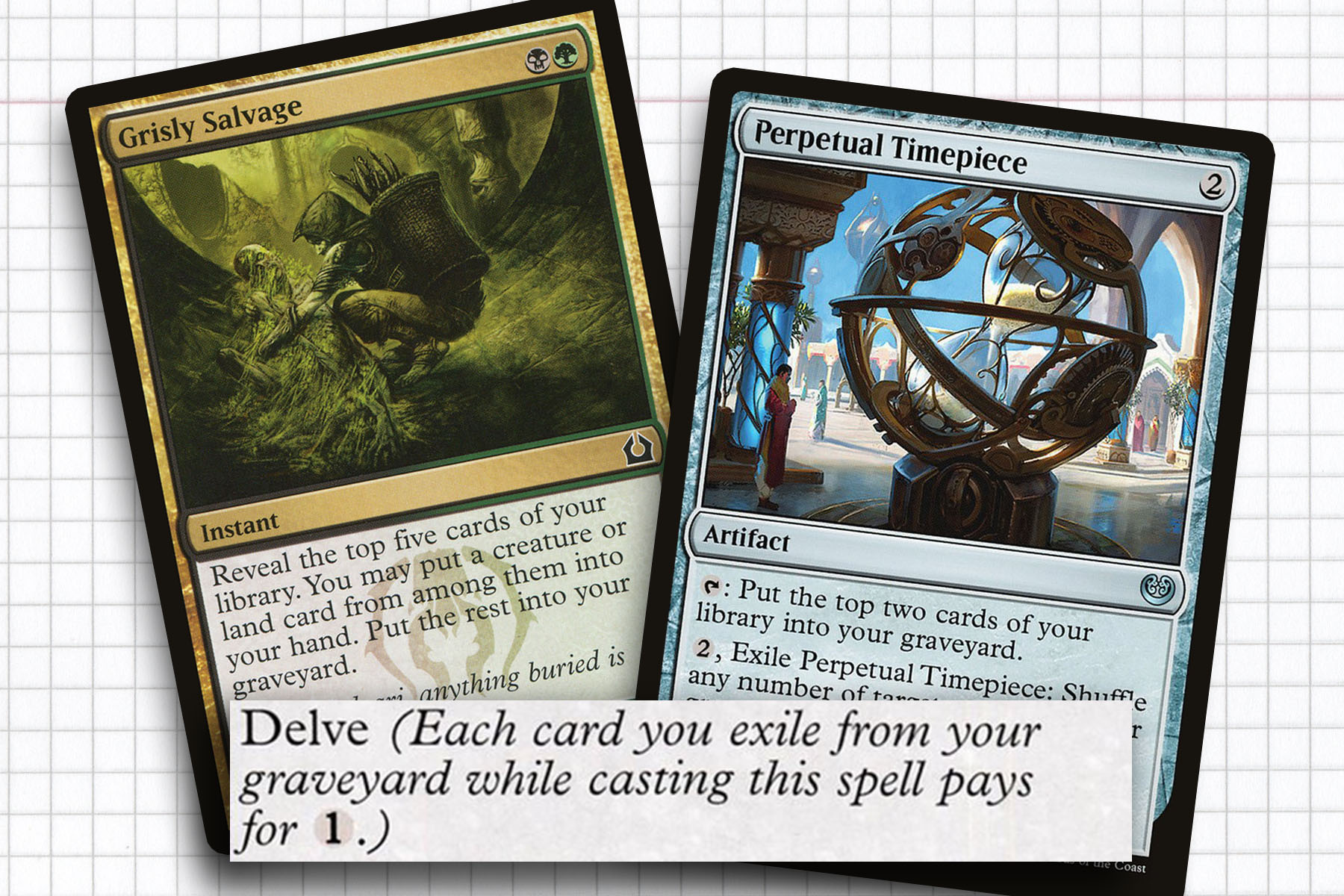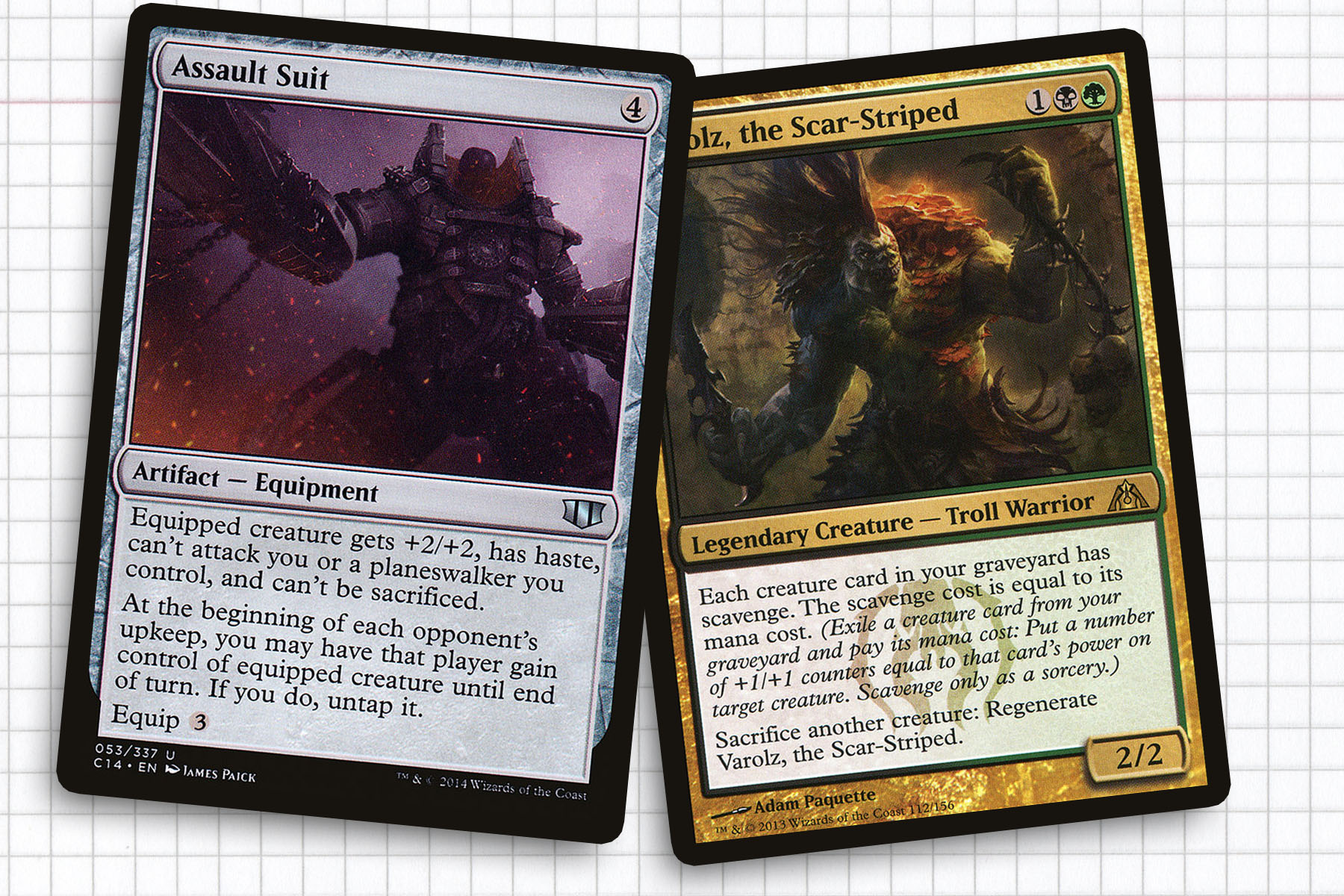Dollar General—[dol-er] [jen-er-uhl]
A variant of the Commander format, itself a casual multiplayer variant format for Magic: the Gathering with specific rules centered around a legendary creature called a General. The additional layer being that every card comprising a 100-card deck must cost less than a US dollar.
With this year’s Commander product finally out, my thoughts turn to the kinds of decks that are going to create a fun experience for people who haven’t gotten into Commander. Dollar General is an interesting variant of Commander, because the decks often have the power level of a preconstructed deck with a personalized touch. Decks rely on draft fodder and the kinds of rares that normally take up space in a trade binder. That means exposure to cards you’ve never seen before, both during deck construction and games.
In the past, I’ve used the format as a vehicle to investigate generals that have seen very little spotlight within constructed formats. But this week we’re going to be looking at a general that was so high profile only a year ago that it required banning in Modern. I’m talking of course about Hogaak, Arisen Necropolis. I aimto appeal to the aggressive at heart, not only because we’re going to be piloting a Voltron general, but we’ll also be converting our library to our graveyard at full speed.
Commander: Hogaak, Arisen Necropolis
Creatures: Crashing Drawbridge, Dawntreader Elk, Deathcap Cultivator, Deep Forest Hermit, Elves of Deep Shadow, Feaster of Fools, Genesis, Glowspore Shaman, Gorging Vulture, Gravebreaker Lamia, Great Oak Guardian, Greater Mossdog, Izoni, Thousand-Eyed, Korozda Guildmage, Satyr Wayfinder, Sengir Autocrat, Shambling Shell, Skull Prophet, Skarrg Goliath, Spawnwrithe, Splinterfright, Splitting Slime, Springbloom Druid, Surrak, the Hunt Caller, Thrashing Mossdog, Varolz, the Scar-Striped
Artifacts: Assault Suit, Chitinous Cloak, Desecrated Tomb, Golgari Signet, Perpetual Timepiece, Talisman of Resilience
Enchantments: Autumnal Gloom, Deadbridge Chant, Moldervine Cloak, Vessel of Nascency, Wolfcaller’s Howl, Zombie Infestation
Instants: Curious Herd, Darkblast, Deathsprout, Golgari Charm, Grisly Salvage, Harrow, Nature’s Claim, Putrefy, Rush of Vitality, Sprout Swarm, Sundering Vitae
Sorceries: Ashen Powder, Bitter Revelation, Commune with the Gods, Feral Incarnation, From Under the Floorboards, Jarad’s Orders, Morbid Curiosity, Ransack the Lab, Saproling Migration, Spider Spawning, Winding Way, Worm Harvest
Lands: 16 Forest, 10 Swamp, Barren Moor, Blighted Woodland, Dakmor Salvage, Foul Orchard, Golgari Guildgate, Jungle Hollow, Myriad Landscape, Polluted Mire, Rogue’s Passage, Slippery Karst, Svogthos, the Restless Tomb, Tranquil Thicket

The Rise and Fall of Hogaak
“It’s an 8/8 trampler. If you can get it out, it’s pretty scary. But it’s a quirky card.”
—Mark Rosewater, Drive to Work Episode #660
It’s funny how time changes things. I agree with Mark Rosewater on this description of Hogaak now, and I think I would have agreed with the sentiment at the time of previewing. But for a window of time in 2019, this quote felt like a huge understatement. In so many ways, Hogaak, Arisen Necropolis was busted and abruptly changed Modern.
Following the release of Modern Horizons, graveyard decks using Hogaak made a huge impact on Modern. As an outsider to the format, I had assumed that the metagame was going to self-correct. But week after week it didn’t change, and even after the banning of Bridge from Below, Hogaak continued to boast very high win rates.
The deck had an oppressive effect on the metagame and was ever-evolving. I remember there was a point where the closest analogue I could personally make was Survival of the Fittest in Legacy circa 2011. It was then no surprise that Hogaak, Arisen Necropolis was banned.
When I realized that Hogaak was legal in Dollar General, I was in disbelief. In hindsight it makes a lot of sense: the card went from format warping to banned and not expressly good anywhere else. Why would it have held its price point? Regardless, in my mind, Hogaak, Arisen Necropolis is a ridiculous card and perfect to be in the command zone.

Need a Helping Hand
Our general can be a fickle master. Hogaak does not allow us to use mana to cast it, instead using the unique overlap of convoke and delve to allow us to pay for it. Convoke itself is a very potent mechanic, because it turns every creature we have in play into a possible source of mana ramp. But with these design constraints to guide us, we will pack our deck with as many creatures that flood the board as we can in an effort to ramp to Hogaak.
For their cost, I think Izoni, Thousand-Eyed, Spider Spawning, and Worm Harvest are going to be the best token creation machines in our deck. All three look at our graveyard for a resource to convert into creature tokens. And as we will soon see, we have lots of ways to fill our graveyard. Following in those footsteps, Curious Herd and From Under the Floorboards both have the potential to not only act as convoke resources, but could also be our way of recovering from a board wipe as solid threats when our opponents are running low on answers.

Salvaging Resources
The graveyard is going to have a huge effect on our deck, including being a place for us to cast our general, subverting commander tax. We’re only required to convoke for the two hybrid mana on our general, meaning that we can canabilize our graveyard with delve if we so wish. Because of that, we’re going to be pushing our suite of cards to fill our graveyard to its upper limits, going so far as to use it as a source of card selection.
The first suite of cards I want to highlight is pretty indiscriminate about what it sends to the graveyard. These cards are in the deck to give us options, possibly a few cards like Perpetual Timepiece or Autumnal Gloom, or in massive swaths through Deadbridge Chant. It should come as no shock that where we can, we’ll also be including dredge. Darkblast, Greater Mossdog, Moldervine Cloak, and Shambling Shell all have a use as spells, but their ability to have repeated use is outclassed by the fact that they will grant us repeated self-mill.
Carelessly getting cards in our graveyard is nice, but green and black also excel at turning self-mill into card selection. Grisly Salvage is one of our top card selection options. As an instant, it allows us to hold up Deathsprout or Putrefy as removal, without losing ground on setting up our next turn. Commune with the Gods and Vessel of Nascency can be critical for their ability to find noncreature, nonland cards if it is relevant. Finally, Bitter Revelation and Ransack the Lab leverage black’s ability to unconditionally give us anything we might require at a moment’s notice.

Assembling Voltron
At this point, casting our general should not be a problem, so we can finally concentrate on how we plan to actually win games. Finding support spells may actually be easier than in other decks, because we’re not going to be using our lands to cast our general, meaning that we’ve almost got double mana on the turns we play them. Therefore equipment like Assault Suit or Chitinous Cloak can stay hidden in our hand until we need to deploy them.
Since our general is huge, doling out damage should not be a concern as much as ensuring that our general actually gets to attack. That’s where Crashing Drawbridge can offer an out-of-color effect, granting haste to our team. More importantly, since we won’t be spending mana on Hogaak, we can cast Surrak, the Hunt Caller on the same turn and surprise unsuspecting opponents with haste.
Our final two cards are going to be best in the endgame, but with different purposes. Varolz, the Scar-Striped should allow us to recycle the remaining creatures in our graveyard to allow Hogaak to administer commander damage faster. This means that savvy players thinking about the game in the long term should consider which creatures may be worth scavenging in the closing turns. It’s never easy to find a good combat trick but subtlety goes out the door when you have Skarrg Goliath, who will be the nail in the coffin of just about any game where it gets discarded to bloodrush.
Building a deck that so aggressively puts cards into its graveyard, only to put the pedal down and go on the offensive, is a new experience for me. I’ve had decks that were mindful of what was going into the graveyard before, but never quite to this degree. Yet this deck fits comfotably in Dollar General, easily assembled for the price of a preconstructed deck with room for powerful upgrades in the future. It may not be perfect, but it sure feels approachable.
Brainstorming with this deck makes me really excited for the next time I can play Commander in paper. One of the most appealing parts of these projects is often proving how much fun you can have on a reasonable budget. This deck currently comes in under $29, which is about the price I would pay for a preconstructed Commander deck at my local store. Even better, these cards are comparable with those decks in terms of power level—you can hand one to a player just getting into the format and give them a solid experience. I hope to see you next time, stay safe.
Ryan Sainio is a Graphic Designer who writes about EDH and the EDH community. He has been playing Magic: The Gathering since 7th Edition in 2002 and values flavorful and fun gameplay over competitively optimized decks.

